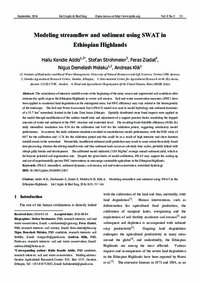Modeling streamflow and sediment using SWAT in Ethiopian Highlands

Authors:
The coincidence of intensive rainfall events at the beginning of the rainy season and unprotected soil conditions after extreme dry spells expose the Ethiopian Highlands to severe soil erosion. Soil and water conservation measures (SWC) have been applied to counteract land degradation in the endangered areas, but SWC efficiency may vary related to the heterogeneity of the landscape. The Soil and Water Assessment Tool (SWAT) model was used to model hydrology and sediment dynamics of a 53.7 km2 watershed, located in the Lake Tana basin, Ethiopia. Spatially distributed stone bund impacts were applied in the model through modification of the surface runoff ratio and adjustment of a support practice factor simulating the trapped amounts of water and sediment at the SWC structure and watershed level. The resulting Nash-Sutcliffe efficiency (NSE) for daily streamflow simulation was 0.56 for the calibration and 0.48 for the validation period, suggesting satisfactory model performance. In contrast, the daily sediment simulation resulted in unsatisfactory model performance, with the NSE value of 0.07 for the calibration and –1.76 for the validation period and this could be as a result of high intensity and short duration rainfall events in the watershed. Meanwhile, insufficient sediment yield prediction may result to some extent from daily based data processing, whereas the driving runoff events and thus sediment loads occur on sub-daily time scales, probably linked with abrupt gully breaks and development. The calibrated model indicated 21.08 Mg/hm2 average annual sediment yield, which is far beyond potential soil regeneration rate. Despite the given limits of model calibration, SWAT may support the scaling up and out of experimentally proven SWC interventions to encourage sustainable agriculture in the Ethiopian Highlands.
